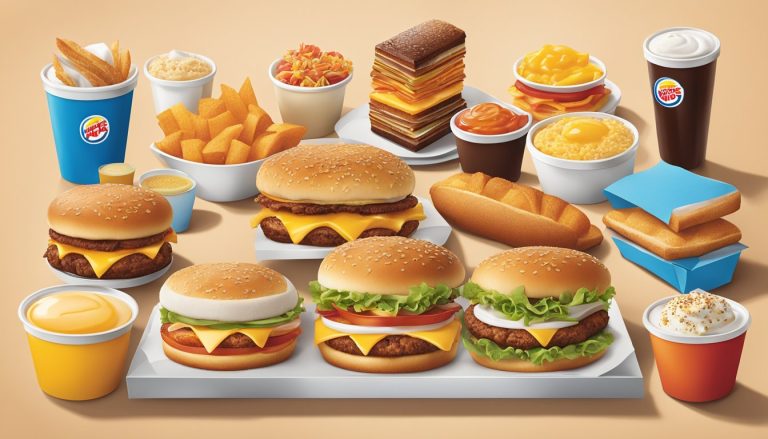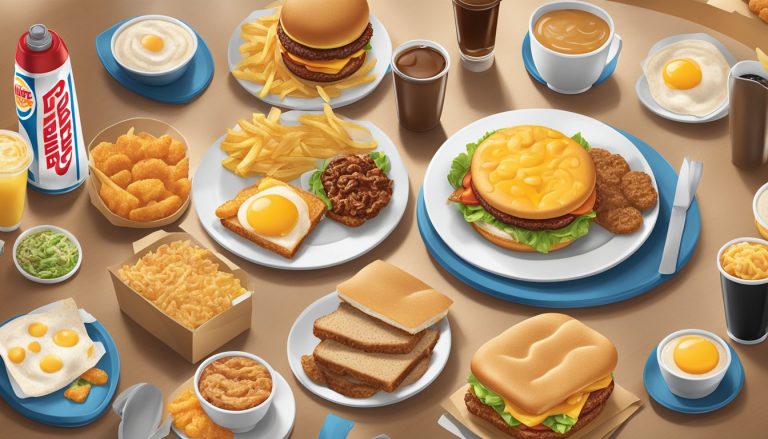Burger King offers a diverse menu throughout the day, catering to various tastes and preferences. The breakfast and lunch options at BK present distinct nutritional profiles, each with its own set of advantages and considerations for health-conscious diners.
Comparing Burger King’s breakfast and lunch menus reveals significant differences in calorie content, macronutrient balance, and overall nutritional value. Breakfast items often feature eggs, cheese, and breakfast meats on croissants, biscuits, or tortillas. Lunch options typically include flame-grilled burgers, chicken sandwiches, and sides like fries.
The nutritional composition of BK’s breakfast and lunch offerings varies widely. Some breakfast items provide protein-rich starts to the day, while certain lunch choices offer more substantial portions. Customers seeking healthier options can find lower-calorie alternatives in both menus, though careful selection is key to maintaining a balanced diet when dining at Burger King.
Understanding the BK Menu

Burger King offers distinct breakfast and lunch menus with varied options and timings. The menu features a range of items catering to different tastes and dietary preferences.
Breakfast at Burger King
Burger King’s breakfast menu includes classic morning favorites. Customers can choose from egg-based sandwiches, pancakes, and hash browns. The BK™ Ultimate Breakfast Platter provides a hearty option with 1190 calories.
Popular breakfast sandwiches come on croissants, biscuits, or English muffins. These may contain eggs, cheese, and meats like bacon, sausage, or ham.
Lighter choices are also available for those watching their calorie intake. Burger King typically serves breakfast until late morning, allowing early risers and late sleepers to enjoy their morning meals.
Lunch Options at Burger King
Burger King’s lunch menu centers around their famous flame-grilled burgers. The Whopper remains a signature item, alongside other burger varieties.
For non-beef eaters, BK offers chicken sandwiches. The Crispy Chicken Sandwich contains 670 calories, while the Original Chicken Sandwich has about 660 calories.
Side options include fries, onion rings, and salads. Burger King also provides plant-based alternatives to cater to vegetarian customers.
Beverage choices range from sodas to milkshakes, complementing the meal options.
Comparing Breakfast and Lunch Timings
Burger King’s breakfast hours typically start early in the morning. Most locations serve breakfast until 10:30 AM on weekdays and 11:00 AM on weekends.
The lunch menu becomes available after breakfast hours end. This transition allows the kitchen to switch from breakfast to lunch preparation.
Some Burger King locations may offer all-day breakfast for select items. However, the full breakfast menu is generally not available after the cut-off time.
Lunch hours extend through the afternoon and evening, giving customers a wider window to enjoy their preferred lunch items.
Nutritional Overview of BK’s Breakfast

Burger King offers a diverse breakfast menu with varying nutritional profiles. The options range from lighter fare to more indulgent choices, catering to different dietary preferences and needs.
Key Breakfast Offerings
Burger King’s breakfast lineup includes popular items like the Croissan’wich, biscuit sandwiches, French toast sticks, and breakfast burritos. The Croissan’wich comes in several varieties, featuring combinations of eggs, cheese, and meats like sausage or ham. Biscuit sandwiches provide a heartier alternative. French toast sticks offer a sweet option, while breakfast burritos cater to those seeking a hand-held meal.
Hash browns are a common side dish, adding a crispy element to breakfast combos. For those with a bigger appetite, BK also offers pancakes as part of their breakfast platter.
Caloric Content in Breakfast Items
Calorie counts in Burger King’s breakfast menu vary widely. On the lower end, a Ham, Egg & Cheese Biscuit contains 370 calories. The Breakfast Burrito Jr. is another relatively lighter option.
French toast sticks (5 piece) contain about 380 calories. The Egg-Normous Burrito, one of the more substantial offerings, packs 805 calories.
Hash browns add around 250-300 calories to a meal. Pancakes, when part of a platter, contribute significantly to the overall calorie count.
Macronutrient Breakdown for Breakfast Options
Protein content in BK’s breakfast items ranges from 15-20 grams for most sandwiches and burritos. The Breakfast Burrito Jr. provides 16.5 grams of protein.
Carbohydrate content varies. Biscuit sandwiches and Croissan’wiches typically contain 27-30 grams of carbs. The Egg-Normous Burrito has a higher carb count due to its larger size.
Fat content is generally high in most breakfast items, with many options containing 20-30 grams. Fiber content is typically low, with most items providing 1-3 grams. The Breakfast Burrito Jr. offers nearly 3 grams of fiber.
Sodium levels are a concern in many breakfast items, with some approaching the recommended daily limit in a single serving.
Nutritional Overview of BK’s Lunch

Burger King’s lunch menu offers a variety of options, ranging from classic burgers to chicken sandwiches and salads. The nutritional content of these items varies widely, with some providing balanced meals while others are higher in calories and fat.
Prominent Lunch Selections
The Whopper remains BK’s signature lunch item, featuring a flame-grilled beef patty topped with fresh vegetables. Chicken sandwiches, such as the Original Chicken Sandwich and Crispy Chicken Sandwich, are popular alternatives. For sides, French fries and onion rings are staples.
BK also offers lighter options like side salads and garden salads. The King Jr Meal provides smaller portions for children. Chicken nuggets and chicken fries serve as protein-rich snacks or meal components.
Specialty items like the Bacon King and mozzarella sticks cater to those seeking indulgent options.
Caloric Content in Lunch Items
Burger King’s lunch items vary significantly in calorie content. A Whopper contains approximately 660 calories, while a Bacon King can exceed 1,000 calories. Chicken sandwiches range from 660-670 calories for the Original and Crispy versions.
French fries add 380 calories for a medium serving, and onion rings contribute about 410 calories. Chicken nuggets provide 170 calories per 4-piece serving.
For lower-calorie options, a side salad contains around 60 calories without dressing. The garden side salad offers a similar calorie count. A hamburger is one of the lighter main dishes at 240 calories.
Macronutrient Profile for Lunch Options
BK’s lunch items generally provide a mix of protein, carbohydrates, and fats. The Whopper delivers 40 grams of protein, 49 grams of carbs, and 40 grams of fat. Chicken sandwiches offer similar protein content with slightly fewer carbs and fat.
French fries primarily contribute carbohydrates, with 47 grams in a medium serving. Chicken nuggets provide a balanced 8 grams of protein, 10 grams of carbs, and 11 grams of fat per 4-piece serving.
Fiber content is generally low across menu items, with salads being the exception. Sodium levels tend to be high, often exceeding 1,000 mg per item. The Bacon King, for instance, contains over 2,000 mg of sodium.
Special Dietary Considerations

Burger King offers menu options to accommodate various dietary needs and preferences. Customers seeking vegetarian, low-calorie, or high-protein choices can find suitable items for both breakfast and lunch.
Vegetarian Options
Burger King’s vegetarian breakfast options include hash browns, French toast sticks, and pancakes. For lunch, the Impossible Whopper provides a plant-based alternative to traditional burgers. This flame-grilled patty is made from soy protein and paired with tomatoes, lettuce, mayonnaise, pickles, and onions on a sesame seed bun.
Side salads and apple slices are available as vegetarian-friendly sides. Veggie burger options may vary by location. Vegetarian customers should note that while these items contain no meat, they may be prepared on shared equipment.
Low-Calorie Menu Items
For breakfast, the Egg and Cheese Croissan’wich contains 300 calories. The French Toast Sticks (3 piece) offer a sweet option at 230 calories. Lunch choices under 400 calories include:
- Hamburger (240 calories)
- Chicken Jr. (390 calories)
- Side salad with light dressing (60 calories)
Opting for grilled chicken instead of fried can significantly reduce calorie intake. Removing high-calorie condiments like mayonnaise or cheese further lowers the calorie count.
Identifying High-Protein Choices
Burger King offers several high-protein options for both breakfast and lunch:
Breakfast:
- Double Sausage, Egg & Cheese Croissan’wich (29g protein)
- Fully Loaded Croissan’wich (25g protein)
Lunch:
- Whopper (28g protein)
- Grilled Chicken Sandwich (32g protein)
- Double Cheeseburger (25g protein)
These items provide substantial protein, supporting muscle growth and satiety. Pairing high-protein choices with fiber-rich sides like apple slices or a side salad can enhance the nutritional value of the meal.
Fast-Food and Healthy Choices
Fast-food restaurants offer convenient options for busy diners. While often criticized for high-calorie menu items, many chains now provide healthier alternatives. Careful selection can lead to more balanced meals.
Making Health-Conscious Decisions
Fast-food establishments increasingly offer nutritious choices. Many menus now include salads, grilled chicken, and fruit options. Oatmeal and yogurt parfaits have become popular breakfast items.
Some chains display calorie counts prominently, aiding informed decisions. Customization allows customers to modify orders for healthier results. Removing high-calorie toppings or sauces can significantly reduce fat intake.
Portion control is crucial when dining out. Choosing smaller sizes or sharing meals helps manage calorie consumption. Some restaurants offer “snack-sized” versions of popular items.
Understanding the Impact of Sodium and Fats
Fast-food meals often contain high levels of sodium and unhealthy fats. Excess sodium intake can contribute to hypertension and cardiovascular issues. Many menu items exceed daily recommended sodium limits in a single serving.
Trans fats, found in some fried foods, pose particular health risks. Some chains have eliminated trans fats from their cooking processes. Saturated fats remain a concern in many fast-food meals.
Reading nutritional information is key to making healthier choices. Many restaurants provide detailed nutrition facts online or in-store. This data helps identify lower-sodium and lower-fat options.
Grilled items generally contain less fat than fried alternatives. Opting for water or unsweetened beverages instead of sugary drinks can significantly reduce calorie intake.
Experience Beyond Food
Burger King offers more than just meals, with amenities and options catering to various customer needs. The fast-food chain prioritizes convenience, family-friendliness, and indulgent treats.
Efficiency of Burger King’s Drive-Thru
Burger King’s drive-thru service emphasizes speed and accuracy. Many locations feature dual lanes to reduce wait times during peak hours. Digital menu boards and mobile ordering integration streamline the process further.
Customers can expect their orders within 3-5 minutes on average. For added convenience, some restaurants offer curbside pickup options. Bottled water and other beverages are easily accessible for quick grab-and-go service.
BK’s Kid-Friendly Options
The King Jr Meal caters specifically to younger diners. It includes child-sized portions of popular menu items like the Hamburger or Chicken Jr. Healthier side options such as applesauce or a side garden salad are available.
BK playgrounds at select locations provide entertainment for children. Many restaurants offer booster seats and high chairs for families dining in. Kid-friendly packaging often features games or characters to engage young customers.
Treats and Desserts
Burger King’s dessert menu satisfies sweet cravings. The Oreo Cookie Shake blends vanilla soft serve with Oreo cookie pieces for a rich, creamy treat. Other options include classic sundaes and hand-spun milkshakes in various flavors.
Seasonal offerings, like holiday-themed pies, add variety to the dessert lineup. For a lighter option, customers can choose a soft-serve cone. BK also offers dessert-inspired coffee drinks, combining indulgence with caffeine for adult patrons.




